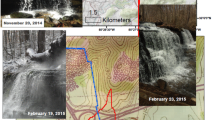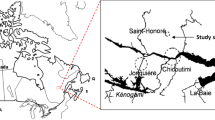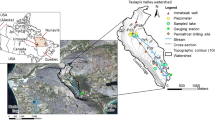Abstract
Research on large northern rivers suggests that as permafrost thaws, deeper groundwater flowpaths become active, resulting in greater baseflow, increased concentrations of weathering ions and reduced concentrations of dissolved organic carbon in the streamflow. In contrast, at the headwater-catchment scale, where understanding of groundwater/surface-water interactions is developed, inter-annual variability in climate and hydrology result in complex hydrological and chemical responses to change. This paper reports on a 4-year runoff investigation in an alpine discontinuous permafrost environment in Yukon, Canada, using stable isotopes, major dissolved ions and hydrometric data, to provide enhanced insight into the inter-annual-variability runoff-generation processes. Stable isotope results suggest that pre-event (old) water stored within the catchment dominates the snowmelt hydrograph, and dissolved ion results reveal that groundwater pathways occur predominantly in the near-surface during freshet. Dissolved organic carbon varies inter-annually, reflecting changing melt patterns, whereas weathering ions generated from deeper flowpaths become diluted. The total snow-water equivalent does not have a major influence on the fraction of snowmelt water reaching the stream or the runoff ratio. Results from multiple years highlight the considerable variability over short time scales, limiting our ability to detect climate-change influences on groundwater at the headwater scale.
Résumé
La recherche sur des grandes rivières du Nord suggère que, lorsque le permafrost fond, des chenaux d’écoulement profonds deviennent actifs, ce dont il résulte un plus grand écoulement de base, des augmentations des concentrations en ions d’altération météorique et une réduction des concentrations en carbone organique dans le flux d’écoulement. Par contraste, à l’échelle de tête de bassin versant, où la compréhension des interactions eau de nappe/eau de surface a été développée, la variabilité inter-annuelle du climat et de l’hydrologie a pour résultat des réponses complexes hydrologiques et chimiques au changement. Cet article rapporte une investigation s’étendant sur quatre ans dans une environnement de typa alpin au Yukon, Canada, utilisant des isotopes stables, les ions majeurs en solution et des données hydrométriques, fournissant une idée affinée de la variabilité interannuelle des processus d’écoulement. Les résultats fournis par les isotopes stables suggèrent que de l’eau anciennement accumulée dans le basin versant domine l’hydrographe de la neige fondue, et les ions en solution révèlent que les chenaux d’écoulement de l’eau de nappe s’établissent de façon prédominante en sub-surface durant la crue. Le carbone organique dissout varie de façon interannuelle, reflétant les variations de conditions de fusion, alors que les ions d’altération générés par les écoulements plus profonds se trouvent dilués. L’équivalent total eau de neige n’a pas une influence majeure sur la fraction d’eau de fusion de neige atteignant le chenal d’écoulement ou sur le ratio découlement. Les résultats de nombreuses années mettent en lumière la variabilité considérable sur des petites échelles de temps, limitant notre capacité de détecter des influences de changement climatique sur l’eau de nappe à l’échelle du bassin versant.
Resumen
La investigación en grandes ríos del norte sugiere que a medida que se deshielan los permafrost, las trayectorias de flujo de aguas subterráneas más profundas se activan, resultado de un mayor flujo de base, concentraciones incrementadas de iones meteorizados y concentraciones reducidas en el carbono orgánico disuelto en la corriente. En contraste, a escala de cabeceras de las cuencas, donde se desarrolla el entendimiento de las interacciones agua superficial / subterránea, la variabilidad interanual en el clima y la hidrología da como resultado respuestas hidrológicas y químicas complejas al cambio. Este trabajo informa una investigación de cuatro años del escurrimiento superficial en un ambiente alpino discontinuo de permafrost en Yukon, Canada, usando isótopos estables, iones disueltos mayoritarios y datos hidrométricos, para proporcionar un conocimiento más profundo en la variabilidad interanual de los procesos que genera el escurrimiento. Los resultados de los isótopos estables sugieren que el agua del pre-evento (vieja) almacenada dentro de la cuenca domina el hidrograma del derretimiento de la nieve, y los resultados de los iones disueltos revelan que las trayectorias del agua subterránea ocurren predominantemente en las proximidades de la superficie durante la crecida. El carbono orgánico disuelto varía interanualmente, reflejando un esquema de derretimiento cambiante, mientras que los iones meteorizados generados a partir de las trayectorias de flujo más profundas se diluyen. El equivalente de agua de nieve total no tiene una mayor influencia en la fracción de agua derretida que alcanza a la corriente o a la tasa de escurrimiento. Los resultados de múltiples año resaltan la considerable variabilidad en cortas escalas de tiempo, limitando nuestra habilidad para detectar las influencias del cambio climático en el agua subterránea a la escala de la cabecera.
摘要
对于北部大型河流的研究显示,当永久冻土层融化时,深部地下水径流开始活跃,导致河川基流增大,水中风化源的离子含量增大,溶解源的有机碳含量减少。与此相反,在源头-流域的尺度上,虽然地下水/地表水的相互作用机理已经确立,但气候与水文的年际变化导致了复杂的水文和化学响应。本文展示了加拿大育空地区的一个高山不连续永久冻土地区四年的径流调查,利用稳定同位素、水中主要离子和水文观测数据加深了对产流的年际变化过程的认识。稳定同位素结果显示,储存在流域内的老水决定了融雪的水文过程线,另外,水中溶解的离子结果表明,地下水的流径主要在洪水期的近地表处出现。水中溶解的有机碳随季节变化,反映了溶解模式的变化,然而来源于深层流径的风化离子的浓度减小。总的融雪水量对到达河川的融水部分和径流系数影响不大。多年观测的结果揭示了短时间尺度下重要的年际变化,这制约着我们在源头认识气候变化对地下水的影响。
Resumo
A pesquisa sobre os grandes rios do norte sugere que, com o degelo do permafrost, há percursos subterrâneos profundos que se tornam ativos para as águas subterrâneas, resultando num maior escoamento de base, num aumento da concentração de iões provenientes da desagregação da rocha e numa redução das concentrações de carbono orgânico dissolvido no fluxo. Em contraste, à escala da cabeceira da bacia, onde se desenvolve a compreensão da interação águas subterrâneas/águas superficiais, a variabilidade interanual no clima e na hidrologia resulta em complexas respostas hidrológicas e químicas. Este artigo relata uma investigação sobre o escoamento superficial durante quatro anos num ambiente de permafrost alpino descontínuo em Yukon, no Canadá, usando isótopos estáveis, os iões principais dissolvidos e dados hidrométricos, para fornecer uma melhor visão da variabilidade interanual dos processos geradores do escoamento. Resultados de isótopos estáveis sugerem que o volume hídrico armazenado anteriormente ao evento do degelo dentro da bacia domina o hidrograma do degelo, e os resultados obtidos a partir dos iões dissolvidos revelam que as vias subterrâneas são predominantes muito próximos à superfície durante a inundação. O carbono orgânico dissolvido varia interanualmente, refletindo os padrões de fusão, enquanto os iões gerados a partir de desagregação mais profunda são diluídos. O volume de água proveniente da neve não tem uma grande influência na fração de água do degelo que alcança o escoamento. Os resultados de vários anos destacam a grande variabilidade em escalas de tempo curtas, limitando a nossa capacidade de detetar a influência das mudanças climáticas nas águas subterrâneas à escala da cabeceira da bacia.




Similar content being viewed by others
References
ACIA (2004) Impact of a warming arctic: Arctic climate impact assessment. Cambridge University Press, Cambridge
Boucher JL, Carey SK (2010) Exploring runoff processes using chemical, isotopic and hydrometric data in a discontinuous permafrost catchment. Hydrol Res 41:508–519. doi:10.2166/nh.2010.146
Carey SK (2003) Dissolved organic carbon fluxes in a discontinuous permafrost Subarctic alpine catchment. Permafrost Periglac Process 16: 369–382
Carey SK, DeBeer CM (2008) Rainfall-runoff hydrograph characteristics in a discontinuous permafrost watershed and their relation to ground thaw. In: Proc., Ninth Int. Conf. on Permafrost. Fairbanks, AL, 29 June–3 July, pp 233–238
Carey SK, Quinton WL (2004) Evaluating snowmelt runoff generation in a discontinuous permafrost catchment using stable isotope, hydrochemical and hydrometric data. Nord Hydrol 35:309–324
Carey SK, Quinton WL (2005) Evaluating runoff generation during summer using hydrometric, stable isotope, and hydrochemical methods in a discontinuous permafrost alpine catchment. Hydrol Process 19:95–114. doi:10.1002/hyp.5764
Carey SK, Woo M-K (2001) Slope runoff processes and flow generation in a subarctic, subalpine environment. J Hydrol 25:110–129. doi:10.1016/S0022-1694(01)00478-4
Cooper LW, Olsen CR, Solomon DK, Larsen IL, Cook RB, Grebmeier JM (1991) Stable isotopes of oxygen and natural and fallout radionuclides used for tracing runoff during snowmelt in an arctic watershed. Water Resour Res 27:2171–2179
Cooper LW, Solis C, Kane DL, Hinzman LD (1993) Application of oxygen-18 tracer techniques to Arctic hydrological processes. Arct Antarct Alp Res 25:247–255
Dornblaser MM, Striegl RG (2007) Nutrient (N, P) loads and yields at multiple scales and subbasin types in the Yukon river basin, Alaska. J Geophys Res 112. doi:10.1029/2006JG000366
Dornblaser MM, Striegl RG (2009) Suspended sediment and carbonate transport in the Yukon river basin, Alaska: fluxes and potential future responses to climate change. Water Resour Res 45. doi:10.1029/2008WR007546
Frey KE, McClelland JW (2009) Impacts of permafrost degradation on arctic River biogeochemistry. Hydrol Process 23:169–182. doi:10.1002/hyp.7196
Frey KE, Siegel KE, Smith LC (2007) Geochemistry of west Siberian streams and their potential response to permafrost degradation. Water Resour Res 43. doi:10.1029/2006WR004902
Genereux DP (1998) Quantifying uncertainty in tracer-based hydrograph separations. Water Resour Res 34:915–919. doi:10.1029/98WR00010
Gibson JJ, Edwards TWD, Prowse TD (1993) Runoff generation in a high boreal wetland in northern Canada. Nordic Hydrol 24213–224
Godsey SE, Kirchner JW, Clow DW (2009) Concentration-discharge relationships reflect chemostatic characteristics of US catchments. Hydrol Process 23:1844–1864. doi:10.1002/hyp.7315
Hinzman LD, Kane DL, Everett KR (1993) Hillslope hydrology in an arctic setting. In: Proc., Sixth Int. Conf. on Permafrost. South China Press, Beijing, pp 257–271
Hinzman LD, Bettez ND, Bolton RW et al (2005) Evidence and implications of recent climate change in northern Alaska and other arctic regions. Clim Chang 71:251–298. doi:10.1007/s10584-005-5352-2
Hoeg S, Uhlenbrook S, Leibundgut C (2000) Hydrograph separation in a mountainous catchment: combining hydrochemical and isotopic tracers. Hydrol Process 14:1199–1216
Jones JB, Rinehart AJ (2010) The long-term response of stream flow to climatic warming in headwater streams of interior Alaska. Can J Forest Res 40:1210–1218. doi:10.1139/X10-047
Jorgenson MT, Shur YL, Pullman ER (2006) Abrupt increase in permafrost degradation in Arctic Alaska. Geophys Res Lett 33. doi:10.1029/2005GL024960
Kane DL, McNamara JP, Yang D, Olsson PQ, Gieck RE (2003) An extreme rainfall/runoff event in Arctic Alaska. J Hydrometeorol 5:1220–1228
Keller K, Blum JD, Kling GW (2010) Stream geochemistry as an indicator of increasing permafrost thaw depth in an arctic watershed. Chem Geol 273:76–81. doi:10.1016/j.chemgeo.2010.02.013
Laudon H, Hemond HF, Krouse R, Bishop KH (2002) Oxygen 18 fractionation during snowmelt: implications for spring flood hydrograph separation. Water Resour Res 38:1258
Lewkowicz AG, Ednie M (2004) Probability mapping of mountain permafrost using the BTS method, Wolf Creek, Yukon Territory, Canada. Permafr Periglac Process 15:67–80
Lyon SW, Destouni G (2010) Changes in catchment-scale recession flow properties in response to permafrost thawing in the Yukon River basin. Int J Climatol 30:2138–2145. doi:10.1002/joc.1993
Lyon SW, Destouni G, Giesler R, Humborg C, Mörth M, Seibert J, Karlsson J, Troch PA (2009) Estimation of permafrost thawing rates in a sub-arctic catchment using recession flow analysis. Hydrol Earth Syst Sci 13:595–604
Lyon SW, Mörth M, Humborg C, Giesler R, Destouni G (2010) The relationship between subsurface hydrology and dissolved carbon fluxes for a sub-arctic catchment. Hydrol Earth Syst Sci 14:941–950. doi:10.5194/hess-14-941-2010
MacLean R, Oswood MW, Irons JG III, McDowell WH (1999) The effect of permafrost on stream biogeochemistry: a case study of two streams in the Alaskan (U.S.A.) taiga. Biogeochemistry 47:239–267
McCartney SE, Carey SK, Pomeroy JW (2006) Intra-basin variability of snowmelt water balance calculations in a subarctic catchment. Hydrol Process 20:1001–1016
McNamara JP, Kane DL, Hinzman LD (1997) Hydrograph separations in an Arctic watershed using mixing model and graphical techniques. Water Resour Res 33:1707–1719
Metcalfe RA, Buttle JM (2001) Soil partitioning and surface store controls on spring runoff from boreal forest peatland basin in north-central Manitoba, Canada. Hydrol Process 15:2305–2324
O’Donnell JA, Aiken GR, Kane ES, Jones JB (2010) Source water controls on the character and origin of dissolved organic matter in streams of the Yukon River Basin, Alaska. J Geophys Res 115. doi:10.1029/2009JG001153
Obradovic MM, Sklash MG (1986) An isotopic and geochemical study of the snowmelt runoff in a small arctic watershed. Hydrol Processes 1:15–30
Petrone KC, Jones JB, Hinzman LD, Boone RD (2006) Seasonal export of carbon, nitrogen, and major solutes from Alaskan catchments with discontinuous permafrost. J Geophys Res 111. doi:10.1029/2005JG000055
Quinton WL, Marsh P (1999) A conceptual framework for runoff generation in a permafrost environment. Hydrol Proc 13:2563–2581
Quinton WL, Sharizi T, Carey SK, Pomeroy JW (2005) Soil water storage and active layer development in a sub alpine tundra hillslope, southern Yukon Territory, Canada. Permafr Periglac Process 16:369–382
Quinton WL, Hayashi M, Carey SK (2008) Peat hydraulic conductivity in cold regions and its relation to pore size and geometry. Hydrol Process 22:2829–2837
Quinton WL, Bemrose RK, Zhang Y, Carey SK (2009) The influence of spatial variability in snowmelt and active layer thaw on hillslope drainage for an alpine tundra hillslope. Hydrol Process 23:2628–2639. doi:10.1002/hyp.7327
Quinton WL, Hayashi M, Chasmer LE (2011) Permafrost-thaw-induced land-cover change in the Canadian subarctic: implications for water resources. Hydrol Process 25:152–158. doi:10.1002/hyp.7894
Schuster PF, Striegl RG, Aiken GR, Krabbenhoft DP, Dewild JF, Butler K, Kamark B, Dornblaser M (2011) Mercury export from the Yukon River Basin and potential response to a changing climate. Environ Sci Technol 45:9262–9267. doi:10.1021/es202068b
Shanley JJ, Kendall C, Smith TE, Wolock DM, McDinnell JJ (2002) Controls on old and new water contributions to stream flow at some nested catchments in Vermont, USA. Hydrol Prcess 16:589–609. doi:10.1002/hyp.312
Sklash MG, Farvolden RN (1979) The role of groundwater in storm runoff. J Hydrol 43: 45–66
Slaughter CW, Kane DL (1979) Hydrologic role of shallow organic soils in cold climates. In: Proceedings, Canadian Hydrology Symposium 79: Cold Climate Hydrology. National Research Council of Canada, Ottawa, pp 380–389
Smith LC, Pavelsky TM, MacDonald GM, Shiklomanov AI, Lammers RB (2007) Rising minimum daily flows in northern Eurasian rivers: a growing influence of groundwater in the high-latitude hydrologic cycle. J Geophys Res 122. doi:10.1029/20
Spence C, Kokelj SV, Ehsanzadeh E (2011) Precipitation trends contribute to streamflow regime shifts in northern Canada. In: Cold region hydrology in a changing climate. IAHS Publ 346, IAHS, Wallingford, UK, pp 3–8
St. Jacques J-M, Sauchyn DJ (2009) Increasing winter baseflow and mean annual streamflow from possible permafrost thawing in the Northwest Territories, Canada. Geophys Res Lett 36. doi:10.1029/2008GL035822
Striegl RG, Aiken GR, Dornblaser MM, Raymond PA, Wickland KP (2005) A decrease in discharge-normalized DOC export by the Yukon river during summer through autumn. Geophys Res Lett 32. doi:10.1029/2005GL024413
Striegl RG, Dornblaser MM, Aiken GR, Wickland KP, Raymond PA (2007), Carbon export and cycling by the Yukon, Tanana, and Porcupine rivers, Alaska, 2001–2005. Water Resour Res 43, W02411. doi:10.1029/2006WR005201
Taylor S, Feng X, Williams M, McNamara J (2002) How isotopic fractionation of snowmelt affects hydrograph separation. Hydrol Process 16:2683–3690. doi:10.1002/hyp.1232
Walvoord MA, Striegl RG (2007) Increased groundwater to stream discharge from permafrost thawing in the Yukon River Basin: potential impacts on lateral export of carbon and nitrogen. Geophys Res Lett 34. doi:10.1029/2007GL030216
Woo M-k (2012) Permafrost hydrology. Springer, Heidelberg, Germany
Acknowledgements
This work is funded by research grants to SKC from NSERC and the CFCAS. The support of Glenn Ford and Ric Janowicz of the Water Resource Branch, Yukon Department of Environment, and the field assistance of Shawn MacDonald and Mike Treberg are gratefully acknowledged.
Author information
Authors and Affiliations
Corresponding author
Additional information
Published in the theme issue “Hydrogeology of Cold Regions”
Rights and permissions
About this article
Cite this article
Carey, S.K., Boucher, J.L. & Duarte, C.M. Inferring groundwater contributions and pathways to streamflow during snowmelt over multiple years in a discontinuous permafrost subarctic environment (Yukon, Canada). Hydrogeol J 21, 67–77 (2013). https://doi.org/10.1007/s10040-012-0920-9
Received:
Accepted:
Published:
Issue Date:
DOI: https://doi.org/10.1007/s10040-012-0920-9




